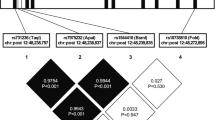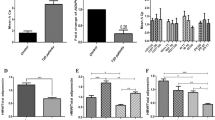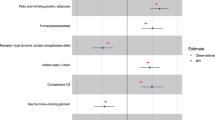Abstract
Objective:
Visceral adipose tissue-derived serine protease inhibitor (vaspin) is an adipokine potentially linking obesity, insulin resistance and type 2 diabetes. Here, we searched for genetic determinants that could explain the variability in serum vaspin concentrations.
Research Design and Methods:
First, we conducted a genome-wide association study (GWAS) for serum vaspin in the Sorbs cohort (N=826). Subsequently, 26 single-nucleotide polymorphisms (SNPs) covering genetic variation in the vaspin locus were genotyped in the Sorbs. In addition, we measured serum vaspin concentrations in 1806 samples from Augsburg/the Cooperative Health Research in the Region of Augsburg (KORA) for replication of the association signals. Finally, we conducted association analyses of vaspin SNPs with metabolic traits in the Sorbs (N=1013), KORA (N=1813) and a further cohort from Germany (Leipzig: N=1857).
Results:
Six SNPs mapping between serpinA1 and serpinA4, including the vaspin locus, on chromosome 14 reached P-values ⩽10−8 in the GWAS in the Sorbs. The fine mapping of variants within the vaspin locus in the Sorbs and subsequent replication in the KORA sample revealed several SNPs significantly associated with serum vaspin concentrations reaching P-values of up to 10−35. However, no significant association with type 2 diabetes or related traits was found in either cohort after the Bonferroni correction for multiple comparisons.
Conclusion:
Our data show that the variability in serum vaspin concentrations might be explained by its genetic variants.
This is a preview of subscription content, access via your institution
Access options
Subscribe to this journal
Receive 12 print issues and online access
$259.00 per year
only $21.58 per issue
Buy this article
- Purchase on Springer Link
- Instant access to full article PDF
Prices may be subject to local taxes which are calculated during checkout



Similar content being viewed by others
References
Kershaw EE, Flier JS . Adipose tissue as an endocrine organ. J Clin Endocrinol Metab 2004; 89: 2548–2556.
Hida K, Wada J, Eguchi J, Zhang H, Baba M, Seida A et al. Visceral adipose tissue-derived serine protease inhibitor: A unique insulin-sensitizing adipocytokine in obesity. Proc Natl Acad Sci USA 2005; 102: 10610–10615.
Klöting N, Berndt J, Kralisch S, Kovacs P, Fasshauer M, Schön MR et al. Vaspin gene expression in human adipose tissue: association with obesity and type 2 diabetes. Biochem Biophys Res Commun 2006; 339: 430–436.
Youn BS, Klöting N, Kratzsch J, Lee N, Park JW, Song ES et al. Serum vaspin concentrations in human obesity and type 2 diabetes. Diabetes 2008; 57: 372–377.
Jeong E, Youn BS, Kim DW, Kim EH, Park JW, Namkoong C et al. Circadian rhythm of serum vaspin in healthy male volunteers: relation to meals. J Clin Endocrin Metab 2010; 95: 1869–1875.
Klöting N, Kovacs P, Kern M, Heiker JT, Fasshauer M, Schön MR et al. Central vaspin administration acutely reduces food intake and has sustained blood glucose-lowering effects. Diabetologia 2011; 54: 1819–1823.
Tönjes A, Koriath M, Schleinitz D, Dietrich K, Böttcher Y, Rayner NW et al. Genetic variation in GPR133 is associated with height: genome wide association study in the self-contained population of Sorbs. Hum Mol Gen 2009; 18: 4662–4668.
Tönjes A, Zeggini E, Kovacs P, Böttcher Y, Schleinitz D, Dietrich K et al. Association of FTO variants with BMI and fat mass in the self-contained population of Sorbs in Germany. Eur J Hum Genet 2010; 18: 104–110.
Veeramah KR, Tönjes A, Kovacs P, Gross A, Wegmann D, Geary P et al. Genetic variation in the Sorbs of eastern Germany in the context of broader European genetic diversity. Eur J Hum Genet 2011; 19: 995–1001.
ADA Standards of medical care in diabetes-2010. Diabetes Care 2010; 33: S11–S61.
Böttcher Y, Teupser D, Enigk B, Berndt J, Klöting N, Schön MR et al. Genetic variation in the visfatin gene (PBEF1) and its relation to glucose metabolism and fat-depot-specific messenger ribonucleic acid expression in humans. J Clin Endocrinol Metab 2006; 91: 2725–2731.
Böttcher Y, Unbehauen H, Klöting N, Ruschke K, Körner A, Schleinitz D et al. Adipose tissue expression and genetic variants of the bone morphogenetic protein receptor 1A gene (BMPR1A) are associated with human obesity. Diabetes 2009; 58: 2119–2128.
Wichmann HE, Gieger C, Illig T . KORA-gen—resource for population genetics, controls and a broad spectrum of disease phenotypes. Gesundheitswesen 2005; 67: S26–S30.
Marchini J, Howie B, Myers S, McVean G, Donnelly P . A new multipoint method for genome-wide association studies via imputation of genotypes. Nat Genet 2007; 39: 906–913.
Purcell S, Neale B, Todd-Brown K, Thomas L, Ferreira MA, Bender D et al. PLINK: a tool set for whole-genome association and population-based linkage analyses. Am J Hum Genet 2007; 81: 559–575.
Willer CJ, Li Y, Abecasis GR . METAL: fast and efficient meta-analysis of genomewide association scans. Bioinformatics 2010; 26: 2190–2191.
Stouffer SA, Suchman EA, DeVinney LC, Star SA, Williams RM . Adjustment During Army Life. Princeton University Press: Princeton, NJ, 1949.
R Development Core TeamR: A language and environment for statistical computing 2008.
de Bakker PIW, Yelensky R, Péer I, Gabriel SB, Daly MJ, Altshuler D . Efficiency and power in genetic association studies. Nat Genet 2005; 37: 1217–1223.
Kawano K, Hirashima T, Mori S, Saitoh Y, Kurosumi M, Natori T . Spontaneous long-term hyperglycemic rat with diabetic complications—Otsuka Long-Evans Tokushima fatty (Oletf) strain. Diabetes 1992; 41: 1422–1428.
Li Q, Chen R, Moriya J, Yamakawa J, Sumino H, Kanda T et al. A novel adipocytokine, visceral adipose tissue-derived serine protease inhibitor (vaspin), and obesity. J Int Med Res 2008; 36: 625–629.
Wada J . Vaspin: a novel serpin with insulin-sensitizing effects. Expert Opin Investig Drugs 2008; 17: 327–333.
Kempf K, Rose B, Illig T, Rathmann W, Strassburger K, Thorand B et al. Vaspin (SERPINA12) genotypes and risk of type 2 diabetes: results from the MONICA/KORA studies. Exp Clin Endocrinol Diab 2010; 118: 184–189.
Dupuis J, Langenberg C, Prokopenko I, Saxena R, Soranzo N, Jackson AU et al. New genetic loci implicated in fasting glucose homeostasis and their impact on type 2 diabetes risk. Nat Genet 2010; 42: 105–116.
Saxena R, Hivert MF, Langenberg C, Tanaka T, Pankow JS, Vollenweider P et al. Genetic variation in GIPR influences the glucose and insulin responses to an oral glucose challenge. Nat Genet 2010; 42: 142–148.
Soranzo N, Sanna S, Wheeler E, Gieger C, Radke D, Dupuis J et al. Common variants at 10 genomic loci influence hemoglobin A(1C) levels via glycemic and nonglycemic pathways. Diabetes 2010; 59: 3229–3239.
Acknowledgements
We thank all those who participated in the studies. We also acknowledge excellent technical assistance by Beate Enigk, Manuela Prellberg, Ines Müller and Janin Berndt. Data on glycaemic traits have been contributed by MAGIC investigators and have been downloaded from www.magicinvestigators.org. This work was supported by grants from the Federal Ministry of Education and Research (BMBF), Boehringer Ingelheim Foundation (to PK and DS), Integrated Research and Treatment Center IFB Adiposity Diseases K7-37, 38, 39 (to YB) and Metarot position (to AT), Competence Network Obesity (FKZ 01GI0829), the Integrierte Verbünde der Medizinischen Genomforschung—NGFN-Plus (FKZ 01GI0827 and 01GS0823), Deutsche Forschungsgemeinschaft (DFG), the Clinical Research Group ‘Atherobesity’ KFO 152 (projects BL 833/1-1 to MB, Stu192/6-1 (MS), KO 3512/1-1 to AK and KO 3880/1-2 to PK, MB and JB), from the German Diabetes Association (to DS and PK), DHFD (Diabetes Hilfs- und Forschungsfonds Deutschland; to MS, PK, MB and AT) and LIFE—Leipzig Research Center for Civilization Diseases, Universität Leipzig. LIFE is funded by means of the European Union, by the European Regional Development Fund (ERDF) and by means of the Free State of Saxony within the framework of the excellence initiative.
Author information
Authors and Affiliations
Corresponding author
Ethics declarations
Competing interests
The authors declare no conflict of interest.
Additional information
Supplementary Information accompanies the paper on International Journal of Obesity website
Supplementary information
Rights and permissions
About this article
Cite this article
Breitfeld, J., Tönjes, A., Böttcher, Y. et al. Genetic variation in the vaspin gene affects circulating serum vaspin concentrations. Int J Obes 37, 861–866 (2013). https://doi.org/10.1038/ijo.2012.133
Received:
Revised:
Accepted:
Published:
Issue Date:
DOI: https://doi.org/10.1038/ijo.2012.133
Keywords
This article is cited by
-
Association of vaspin rs2236242 with type 2 diabetes mellitus and obesity: a meta-analysis of case-control studies
Journal of Diabetes & Metabolic Disorders (2022)
-
Vaspin in atherosclerotic disease and cardiovascular risk in axial spondyloarthritis: a genetic and serological study
Arthritis Research & Therapy (2021)
-
The role of vaspin as a predictor of coronary angiography result in SCAD (stable coronary artery disease) patients
BMC Cardiovascular Disorders (2017)



